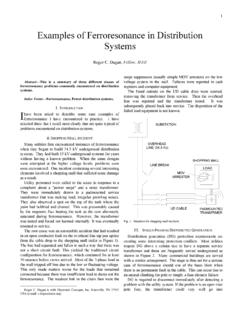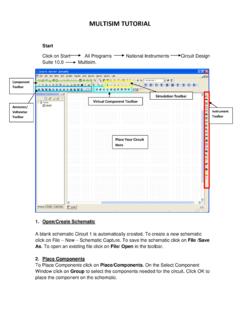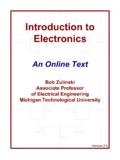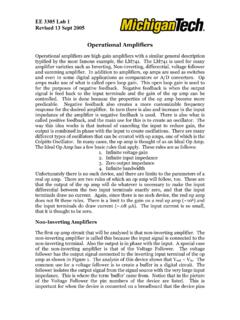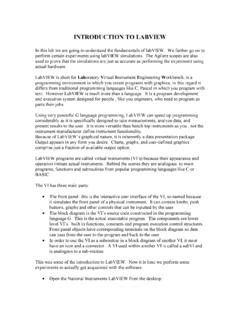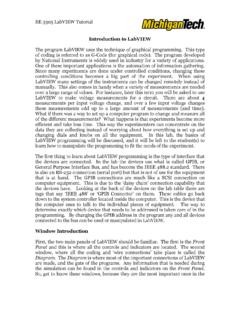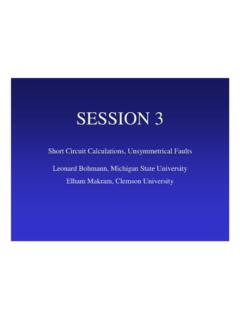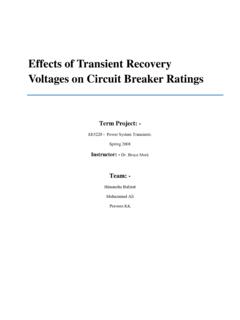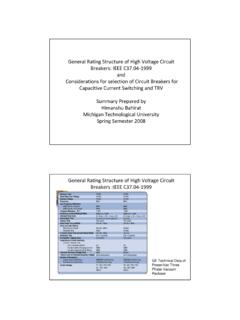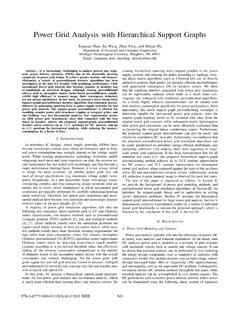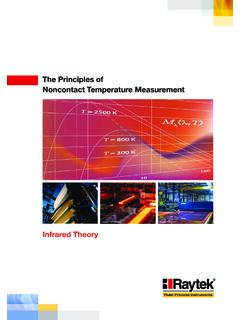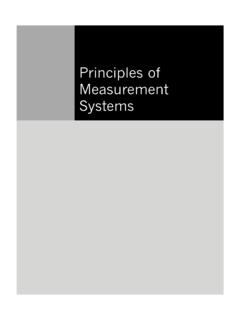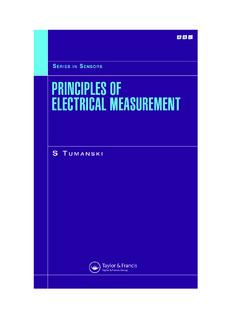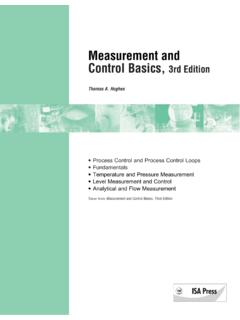Transcription of Chapter 9 Computer-Based Instrumentation Systems
1 ELECTRICALENGINEERINGP rinciples and ApplicationsSE OND EDITIONC hapter 9 Computer-Based Instrumentation SystemsChapter 9 Computer-Based InstrumentationSystems1. Describe the operation of the elements of a Computer-Based Instrumentation Identify the types of errors that may be encountered in Instrumentation and ApplicationsSE OND EDITIONC hapter 9 Computer-Based Instrumentation Systems3. Avoid common pitfalls such as ground loops, noise coupling, and loading when using Determine specifications for the elements of Computer-Based Instrumentation Systems such as data-acquisition Know how to use LabVIEW to create virtual instruments for computer -aided test and control Systems in your field of and ApplicationsSE OND EDITIONC hapter 9 Computer-Based Instrumentation SystemsELECTRICALENGINEERINGP rinciples and ApplicationsSE OND EDITIONC hapter 9 Computer-Based Instrumentation SystemsOverview of Computer-Based InstrumentationELECTRICALENGINEERINGP rinciples and ApplicationsSE OND EDITIONC hapter 9 Computer-Based Instrumentation SystemsELECTRICALENGINEERINGP rinciples and ApplicationsSE OND EDITIONC hapter 9 Computer-Based Instrumentation Systems .
2 When we need to measure the internal voltage of the sensor, we should specify asignal-conditioning amplifier having an input impedance that is much larger in magnitude than the Th venin impedance of the and ApplicationsSE OND EDITIONC hapter 9 Computer-Based Instrumentation SystemsELECTRICALENGINEERINGP rinciples and ApplicationsSE OND EDITIONC hapter 9 Computer-Based Instrumentation Systems .. when we want to sense the current produced by a sensor, we need a current-to-voltage converter having a very small (ideally zero) input impedance and ApplicationsSE OND EDITIONC hapter 9 Computer-Based Instrumentation SystemsELECTRICALENGINEERINGP rinciples and ApplicationsSE OND EDITIONC hapter 9 Computer-Based Instrumentation SystemsErrors in measurement SystemstrueErrorxxm =%100error Percentagefulltrue =xxxmELECTRICALENGINEERINGP rinciples and ApplicationsSE OND EDITIONC hapter 9 Computer-Based Instrumentation SystemsELECTRICALENGINEERINGP rinciples and ApplicationsSE OND EDITIONC hapter 9 Computer-Based Instrumentation Systems1.
3 Accuracy: The maximum expected difference in magnitude between measured and true values (often expressed as a percentage of the full-scale value).2. Precision: The ability of the instrument to repeat the measurement of a constantmeasurand. More precise measurements have less random and ApplicationsSE OND EDITIONC hapter 9 Computer-Based Instrumentation Systems3. Resolution: The smallest possible increment discernible between measured values. As the term is used, higher resolution means smaller increments. Thus, an instrument with a five-digit display (say, to ) is said to have higher resolution than an otherwise identical instrument with a three-digit display (say, to ).ELECTRICALENGINEERINGP rinciples and ApplicationsSE OND EDITIONC hapter 9 Computer-Based Instrumentation SystemsSIGNAL CONDITIONINGSome functions of signal conditioners are: 1.
4 Amplification of the sensor signals2. conversion of currents to voltages3. supply of (ac or dc) excitations to the sensors so changes in resistance, inductance, or capacitance are converted to changes in voltage4. filtering to eliminate noise or other unwanted signal componentsELECTRICALENGINEERINGP rinciples and ApplicationsSE OND EDITIONC hapter 9 Computer-Based Instrumentation SystemsELECTRICALENGINEERINGP rinciples and ApplicationsSE OND EDITIONC hapter 9 Computer-Based Instrumentation SystemsELECTRICALENGINEERINGP rinciples and ApplicationsSE OND EDITIONC hapter 9 Computer-Based Instrumentation SystemsSingle-Ended Versus Differential Amplifiers21vvvd =()21cm21vvv+=ELECTRICALENGINEERINGP rinciples and ApplicationsSE OND EDITIONC hapter 9 Computer-Based Instrumentation SystemsELECTRICALENGINEERINGP rinciples and ApplicationsSE OND EDITIONC hapter 9 Computer-Based Instrumentation SystemsGround Loops.
5 In connecting a sensor to an amplifier with asingle-ended input, we should select a floating and ApplicationsSE OND EDITIONC hapter 9 Computer-Based Instrumentation SystemsELECTRICALENGINEERINGP rinciples and ApplicationsSE OND EDITIONC hapter 9 Computer-Based Instrumentation SystemsELECTRICALENGINEERINGP rinciples and ApplicationsSE OND EDITIONC hapter 9 Computer-Based Instrumentation SystemsELECTRICALENGINEERINGP rinciples and ApplicationsSE OND EDITIONC hapter 9 Computer-Based Instrumentation SystemsELECTRICALENGINEERINGP rinciples and ApplicationsSE OND EDITIONC hapter 9 Computer-Based Instrumentation SystemsNoiseElectric field coupling of noise can be reduced by using shielded coupled noise is reduced by using coaxial or twisted-pair and ApplicationsSE OND EDITIONC hapter 9 Computer-Based Instrumentation SystemsANALOG-TO-DIGITAL CONVERSIONIf a signal contains no components with frequencies
6 Higher thanfH, all of the information contained in the signal is present in its samples, provided that the sampling rate is selected to bemore than and ApplicationsSE OND EDITIONC hapter 9 Computer-Based Instrumentation SystemsAnalog-to-digital conversion is a two-step process. First, the signal is sampled at uniformly spaced points in time. Second, the sample values are quantized so they can be represented by words of finite and ApplicationsSE OND EDITIONC hapter 9 Computer-Based Instrumentation SystemsELECTRICALENGINEERINGP rinciples and ApplicationsSE OND EDITIONC hapter 9 Computer-Based Instrumentation SystemsAliasingELECTRICALENGINEERINGP rinciples and ApplicationsSE OND EDITIONC hapter 9 Computer-Based Instrumentation SystemsELECTRICALENGINEERINGP rinciples and ApplicationsSE OND EDITIONC hapter 9 Computer-Based Instrumentation SystemsQuantization NoisekN2=32rms =qNThe effect of finite wordlength can be modeled asadding quantization noise tothe reconstructed and ApplicationsSE OND EDITIONC hapter 9 Computer-Based Instrumentation SystemsELECTRICALENGINEERINGP rinciples and ApplicationsSE OND EDITIONC hapter 9 Computer-Based Instrumentation SystemsLabVIEWLabVIEW.
7 A product of National Instruments, is an industry-standard program used by all types of engineers and scientists for developing sophisticated Instrumentation Systems such as the time frequency vibration analyzer. LabVIEW is an acronym for Laboratory Virtual Instrument Engineering and ApplicationsSE OND EDITIONC hapter 9 Computer-Based Instrumentation SystemsELECTRICALENGINEERINGP rinciples and ApplicationsSE OND EDITIONC hapter 9 Computer-Based Instrumentation SystemsELECTRICALENGINEERINGP rinciples and ApplicationsSE OND EDITIONC hapter 9 Computer-Based Instrumentation SystemsELECTRICALENGINEERINGP rinciples and ApplicationsSE OND EDITIONC hapter 9 Computer-Based Instrumentation SystemsELECTRICALENGINEERINGP rinciples and ApplicationsSE OND EDITIONC hapter 9 Computer-Based Instrumentation SystemsELECTRICALENGINEERINGP rinciples and ApplicationsSE OND EDITIONC hapter 9 Computer-Based Instrumentation SystemsELECTRICALENGINEERINGP rinciples and ApplicationsSE OND EDITIONC hapter 9 Computer-Based Instrumentation SystemsELECTRICALENGINEERINGP
8 Rinciples and ApplicationsSE OND EDITIONC hapter 9 Computer-Based Instrumentation SystemsELECTRICALENGINEERINGP rinciples and ApplicationsSE OND EDITIONC hapter 9 Computer-Based Instrumentation SystemsELECTRICALENGINEERINGP rinciples and ApplicationsSE OND EDITIONC hapter 9 Computer-Based Instrumentation Systems
